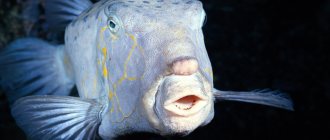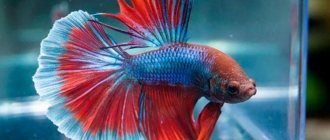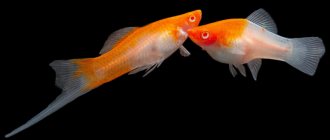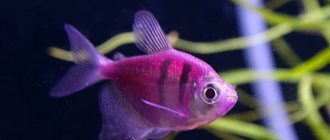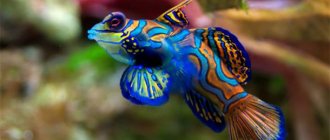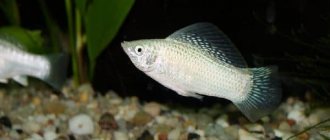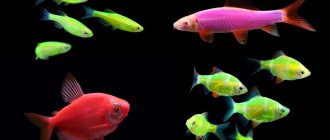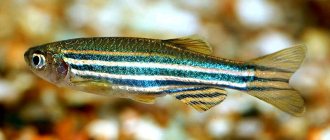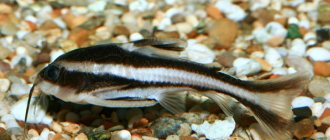4.3
(23)
When many people hear the word “aquarium,” they associate it with a container in which angelfish, goldfish, or some kind of guppies or swordtails live. Undoubtedly, these are very popular animals. However, the underwater world is much more diverse than a person can imagine.
The ocean is practically unexplored, and therefore we have not yet seen a lot of creatures living in it. However, we do know of some unusual fish, and some people have successfully kept them in aquariums at home, recreating the natural conditions for these animals.
Today, unusual aquarium fish are presented in a huge variety. But certain species are especially popular among aquarists.
Dragon goby
This amazing creature with a bizarre appearance evokes a variety of emotions in people. However, by its nature it is very peaceful and does not pose a danger.
Lives in bodies of water near America. Starting from the southern part of the USA to Brazil and other neighboring countries. Their natural habitat is deltas and estuaries of rivers flowing into the ocean. That is, they prefer brackish water.
The conditions of detention are not particularly difficult, but there are some nuances. Firstly, the volume of the aquarium must be at least 450 liters. Secondly, you need a lot of soil, a layer of about 7-10 cm, with a fine fraction, since this creature likes to burrow into the substrate. Thirdly, it needs to provide the required water salinity, 5-15 grams. per liter of water. That is, you will need equipment for marine aquariums.
In nature, individuals grow up to 60 cm, in aquariums, of course, less. The diet is simple, as these fish eat plant foods. In rivers it feeds on filamentous algae, but can also be accustomed to dry food.
Nannakara neon
Neon Nannakara
A very unusual fish, the appearance of which is still not known for sure. According to experts, this is a hybrid , the result of crossing some American cichlids.
If you take a closer look at Nannakara, it will immediately become clear why it is so popular among aquarists. The fish has bright blue scales with a golden-pearl sheen. A well-developed dorsal fin stretches from the tail to the head and has a yellow edging on top. The body size is on average 13 cm, the required aquarium volume for a couple is from 100 liters. Nannakars are quite peaceful and hardy.
Bornean tetradon
An interesting animal, but rarely found on sale. Most often in stores you can see its “relative”, the red-eyed tetradon. In nature it has a narrow habitat. This is the northern part of the island of Borneo, a river with a slow current and dense coastal vegetation.
Adult fish grow to only 4-5 cm. Therefore, they do not need a large aquarium. However, finding neighbors for them is not easy. Firstly, these animals are amazing because they have spines all over their bodies, and if danger arises, they swell (like in the cartoon “Shark Tale”).
In nature, tetradon feeds on food of animal origin. It has something like a beak, thanks to which it can eat crustaceans (crabs, shrimps), and mollusks. Accordingly, an aquarium resident should have the same diet. It is important that it be hard, so that the “beak” will grind off.
Red neon
Red Neon
Red Neons are often found in aquascapes , as these small fish are the most beautiful representatives of the Characin family. The peculiarity of red neons is 2 red stripes running along the entire body (one is bright red and the other is blue, with a characteristic neon glow).
The body size does not exceed 5 cm. The fish are kept in schools, and the larger the group, the better it looks. Neons get along well with peace-loving fish and living plants.
Sundalance
One of the most unusual representatives of underwater fauna on this list for a number of reasons. Firstly, it is extremely rare to find on sale. Secondly, it has an unusual appearance. It is quite difficult to maintain, so it is recommended only for experienced aquarists to keep it.
In nature, it lives in Thailand and Malaysia, in reservoirs with muddy and stagnant water. During the day it stays near the bottom, in the evening it rises to the surface. This animal is very unusual because:
- Grows no more than 2 cm in nature;
- It has no color, as it is almost completely transparent;
- Does not reproduce in aquariums. Wild caught;
- It can be planted in a nano-aquarium, but it is better to keep it as a separate species.
Lyalius
Lalius
A small labyrinth fish that can decorate any tropical aquarium. Lalius clearly exhibits sexual dimorphism: females are of no value in terms of beauty (like most other species), but males will never be left without attention. Their silver body is covered with red and blue luminous stripes (although there are breeding forms with other color options). Over the course of evolution, the pectoral fins have become thin, sensitive filaments .
The body size of the lalius is 6-7.5 cm. A large aquarium is not needed - 40 liters is enough. Lalius are compatible with most ornamental fish of the same size.
Elephant fish or mormyrids
It also has a rather original appearance. It is not common, since it is quite difficult to achieve results when breeding. In addition, to keep elephant fish, you need to create special conditions, which only an experienced aquarist can provide.
Found naturally in the waters of central Africa. It stays near the bottom, in silted rivers with dense vegetation. A distinctive feature of these fish is their unusual mouth, slightly reminiscent of a trunk. Thanks to it, the animal digs in the mud and looks for food. It is nocturnal, so it does not rely on vision when moving. The elephant fish has a special organ in its tail that releases short electrical impulses. The head contains receptors that respond to changes in the area. That is, this animal has a kind of electrical radar.
In an aquarium, fish need to be allocated an aquarium of at least 250 liters. The substrate should be shallow so that she can rummage through it. The best diet is worms and crustaceans. There must be a lot of plants. From the neighbors you can choose calm, smaller species. The main thing is that they stay close to the surface, since the elephant fish aggressively defends its bottom territory and can kill its rival.
Turquoise Akara
Acara turquoise
One of the most beautiful cichlids in South America. Her bluish-green scales seem to be surrounded by a luminous halo. And near the head there are turquoise stripes and spots. The dorsal and anal fins are strongly elongated. A yellow or white edging is clearly visible on them (as well as on the tail). Males often have a fatty growth on their heads. Another name is “green terror”.
On a note ! For maintenance you need an aquarium with a volume of at least 300 liters (if it is a species one). Acara is a territorial fish, unable to get along even with species of similar size.
Hindustoma
Her unusual appearance has a purely practical function. First of all, it is necessary so that the animal can easily avoid attacks from predators. In general, it is not whimsical and even a beginner can start it.
Lives on the Malay Peninsula, in the provinces of Thailand and Malaysia. Found in peat bogs and marginal bodies of standing water. In such places at the bottom there are many snags, leaves, bark and all kinds of vegetation.
Visually, the fish resembles a small branch, which it readily uses when hiding in the thickets. It grows up to 3 cm and feeds mainly on crustaceans, small worms and other similar foods that are small in size.
A small aquarium is suitable for individuals. The main thing is that it has enough shelter and minimal current. You can add any small and peaceful neighbors to these fish (for example, zebrafish, neons).
Viviparous
Viviparous fish species differ from others in that they give birth to offspring without laying eggs. In addition, representatives of livebearers are the most unpretentious aquarium fish, which are ideal for beginners. These phenotypes include the following types.
Guppy
These are nimble and unpretentious fish for a small aquarium. Guppies are rightfully considered one of the best aquarium fish for those starting their journey in the aquarium hobby. These are viviparous fish that are easy to keep in an aquarium - guppies are peaceful, do not get into fights in the tank, and are unpretentious in matters of feeding. At the same time, caring for and maintaining guppy fish requires certain knowledge. Breeding aquarium fish at home can be done in a species pond, but after the offspring appear, it is better to place the fry in a separate container.
Guppies prefer to live in schools, so it is recommended to purchase 5-8 pieces at once. Males are more intensely colored than females and have lush veil fins. When purchasing, you should ask the seller how long guppies live, as well as where the fish on display come from, since guppies from distant countries do not tolerate transportation well, weaken and may die.
Befortia
Visually it resembles a stingray, but, unlike its marine counterpart, it reaches only 8 cm in length. It is found naturally in Hong Kong and Southeast Asia, namely in bodies of water with cold water, fast currents and a rocky bottom. It holds onto the bottom quite tightly and moves quickly, thanks to which it is able to cope with such living conditions.
It is not particularly difficult to keep, but more often befortia is kept by experienced aquarists. She needs cold water 20-23 degrees. It is important that it is clean and has a strong current. The presence of snags, stones and other shelters is required. In addition, aeration is important, since in nature in rivers and streams the water is highly saturated with oxygen. It is not difficult to choose a diet, since the animal eats algae and various plant foods.
Glofish
Glofish
Glofish is the result of the efforts of genetic engineers. The genes of marine coelenterates are introduced into the DNA of the fish, due to which some species have the ability to fluoresce, i.e., biological luminescence. Under an ultraviolet or blue lamp, the glowfish flashes like a neon advertisement. Although the fish have an unusual bright color even without special lighting.
Keeping genetically modified fish is no different from keeping conventional species. In addition, fluorescent genes are passed on hereditarily, and all subsequent generations will also “glow.”
Flower Horn
This creature will especially appeal to cichlid lovers. She has an unusual character, behavior and appearance. Today there are many varieties of this fish, as it can breed with other species of cichlids. This allowed breeders to show their imagination and develop extremely unusual forms.
In fact, the Flower Horn is a hybrid in itself, bred by Malaysian hobbyists. It is not known what species were crossed, but aquarists managed to produce an excellent specimen that is not prone to disease, has a beautiful appearance and is able to reproduce.
This animal is of such interest to aquarists because it changes its color several times throughout its life. They are usually kept separately, as they are very aggressive towards other neighbors. They grow up to 30-40 cm, and therefore they need to choose a large and spacious aquarium. If you want to start a flock, then you need a capacity of about a ton or more.
Which aquarium fish are best to buy?
For their first aquarium, beginners are advised to choose the most stress-resistant and peaceful fish that can calmly coexist with each other. New, newly installed aquariums do not yet have the necessary microflora; bacterial preparations can only aggravate the situation and harm delicate fish.
In any case, before going to the pet store, you should measure the hardness and pH level of the water you will use. Each type of fish requires its own conditions for a comfortable existence.
Another important criterion is the size of the aquarium. Unfortunately, unscrupulous sellers sometimes offer fish that are too large to survive in small containers. It is better to first study the desired breed of fish yourself: find out what size they grow to, and how they live in their natural environment - alone, in pairs or in schools.
Many species of fish change not only their behavior but also their colors as they grow older. For example, a small iris is extremely inconspicuous, but as it grows up it acquires a bright color and becomes a real decoration of the aquarium.
Recommendations: 10 Best Aquariums
10 best terrariums
12 Best Aquarium Plants
Kalamoicht Calabar or snake fish
Visually, many people confuse this fish with a snake. But in fact, this is a common fish from the point of view of classification. It is distinguished by an elongated body and two small processes at the end of the head.
In nature, the kalamoicht lives in the waters of western Africa. These are often rivers with low oxygen content, which is why the fish have adapted and are able to breathe normal atmospheric air. It is often seen on the banks if there is sufficiently high humidity there. Therefore, when keeping this fish in an aquarium, you need to take into account that it is curious and can get out of it if it is poorly covered.
The kalamoicht needs a large capacity of 200 liters, as it grows up to 40 cm in aquarium conditions. This is a fairly peaceful fish, but it can eat neighbors that are too small, as it is a predator by nature. Accordingly, you need to feed it meat foods, namely shrimp, squid, and fish fillets. As for breeding, this process has not yet been successful for aquarists. Individuals are mainly caught in the wild.
We recommend reading the article: Keeping Kalamoichtas Calabarsky in the aquarium
Blue Dempsey
Blue Dempsey
A color variation of the popular eight-striped cichlid, one of the most beautiful inhabitants of the aquarium. The fish has a rich blue color with a shimmering effect. Moreover, the brightness may increase as they grow older. Body size does not exceed 20 cm.
Important ! To keep a pair of Blue Dempseys you need an aquarium of at least 150 liters. Fish have a balanced, calm character.
Arowana
Today it is considered one of the most expensive aquarium fish. There are specimens that cost up to $400,000.
The natural habitat of this creature is South America, namely the Amazon and Guyana. It grows up to 1.20 m and is distinguished by a long body along which the ventral and dorsal fins are located. Well, and of course, the “calling card” of this animal is its two small antennae at the end of its muzzle.
The peculiarity of the arowana is that it is an aggressive hunter. Its mouth and eyes are positioned so that it can grab food from the surface of the water or even above it. The shape of the body allows the fish to jump out of the reservoir to a height of up to 3 meters, thanks to which it can grab insects and even small birds.
When keeping in an aquarium, you need to take into account that this animal loves space, and therefore it is better to allocate at least 500 liters for one individual. As a rule, they keep arowana one at a time, since they are very aggressive towards their relatives, and other fish can become their food. The diet includes seafood, fish, beef heart, and frogs. But it is best to buy special food that floats on the surface, since this creature is accustomed to catching food above itself.
Guppy
Guppy
Guppy is the most famous aquarium fish, which does not lose popularity, despite its small size and long history. This is explained, first of all, by the unpretentiousness of guppies, ease of reproduction and a wide variety of colors.
It is difficult to count the number of breeding forms of guppies. There are varieties that differ in the color of the body and caudal fin. The shape of the tail also varies.
Fish black knife
Quite a curious animal, which, due to its appearance, is significantly different from many others and is easily recognized even by novice aquarists.
They live, like the arowana, in the Amazon, in areas with plenty of cover, slow currents and a shallow sandy substrate. If the region experiences a rainy season, the animal may leave its previous habitat and go to flooded areas of forests. They lead an exclusively nocturnal lifestyle. During the day they hide from the sun in shaded areas.
In aquariums, individuals grow up to 50 cm, and therefore they need to be provided with space. The body shape resembles a knife. Fins are practically absent. They move using a long anal fin, and the tail has evolved into a vestigial organ.
These creatures have almost no vision. They create a small electric field around themselves, thanks to which they find food for themselves. And the long anal fin allows them to move easily in any direction.
It easily combines with other fish in the aquarium, but it is important that they are not too small, otherwise they will become food for the knife fish. They feed on animal food, namely shrimp, mussels, bloodworms, brine shrimp, etc.
Nothobranchius
Nothobranchius
Among the spawning carp-toothed fish there are very beautiful fish, the body color of which resembles the pattern of orchid flowers. The life cycle of the African species of Nothobranchius is closely related to the rainy and dry seasons. With the onset of the rainy season, these fish emerge from eggs , and then, quickly reaching sexual maturity, spawn until the very beginning of the drought. Moreover, the eggs can be in the hibernation stage for up to 6 months. Therefore, the life of nothobranchius is very short, despite even being kept at home. However, the fish are still very popular due to their stunning colors.
Pantodon or butterfly fish
If you want to have an unusual, but unpretentious fish, then this creature is perhaps the best choice. The butterfly fish is small in size (up to 12 cm) and peaceful in nature. In addition, it is unpretentious in maintenance, and thanks to its appearance it can become a decoration for any aquarium.
This animal got its name because of its unusually large pectoral fins. They have two purposes: hunting insects and protecting them from predators. If desired, the fish can jump out of the reservoir and fly quite a long distance. Therefore, if you keep it in an aquarium, it must be covered with a lid, otherwise the pet may run away if some fly suddenly flies over it.
Her menu should contain exclusively meat products. For example, brine shrimp, bloodworms, worms, shrimp and other similar foods. An aquarium of 80 liters or more is suitable for one individual or a couple. But the main thing is that at least half of its volume is open for free floating. Almost any fish from the neighbors will do, with the exception of small or aggressive species (for example, barbs).
We recommend reading the article: Unpretentious aquarium fish
The best fish from the carp family
The carp family has more than 1,500 species. Most of them are recommended for the beginning aquarist. Caring for these fish is easy, and they get along easily with most other breeds.
Cherry barb is the best schooling fish
5
★★★★★
editorial assessment
99%
buyers recommend this product
See review▶
The cherry barb is a small fish with an oblong body, slightly flattened laterally, no more than 5 cm long. Bright red fins are decorated with black edging. Males are completely scarlet, while females are silver-olive. These fish live in schools of 6-10 individuals. For that quantity, a small reservoir with a volume of 50 liters is enough.
Barbs are very shy and hide in secluded places at the slightest danger, so it is recommended to place them in an aquarium with a large number of plants. The lighting should not be too bright, otherwise the fish will be even more scared. Barbus also does not like too warm water. The ideal temperature is 22-24 degrees. Otherwise, this fish does not have high demands on the quality of water and food.
Pros:
- suitable for small aquariums;
- bright color;
- peaceful nature;
- easy care.
Minuses:
- very shy;
- cannot be housed with veiled tails.
The cherry barb gets along with almost everyone, but it shows interest in fluffy tails and fins and can bite them off.
The Sumatran barb is the most active inhabitant of aquariums
5
★★★★★
editorial assessment
96%
buyers recommend this product
See review▶
The Sumatran barb is an active fish that always remains in sight and pleases the owner with its appearance. These pets grow up to 7 cm in length. Their yellow-orange body is decorated with 4 distinct black stripes. The lifespan of a barb in aquariums does not exceed 5 years, but they often die earlier due to improper maintenance. The Sumatran species is peaceful, but due to its restlessness it will force all slow neighbors to hide.
Barbus quickly adapts to any living conditions and does not experience stress when moving. To populate a flock, a long aquarium with a volume of at least 50 liters is recommended. The water should be soft, the recommended temperature is 20-25 degrees. It is better to fill the soil with colored soil. With light sand, the color of the fish may become less bright.
Pros:
- beautiful color;
- adapts to any living conditions;
- does not require complex care;
- always in sight.
Minuses:
- aggressive.
When resting, the Sumatran barb hovers in the water, lowers the front part of its body down and hangs at an angle to the bottom. Inexperienced aquarists think that the fish is unhealthy; in fact, this is a sleep feature inherent to a particular species.
Comet - an unpretentious goldfish
4.9
★★★★★
editorial assessment
92%
buyers recommend this product
See review▶
Comet is a breed of goldfish artificially bred for aquariums. Its body shape is oblong, its tail is long and veil-like. It is often two to three times the length of the body and resembles fluttering fabric. The length of the comet is on average 15–20 cm. The color is orange or red, there are light spots on the sides. Aquarists consider fish that have a different body and fin color to be especially valuable.
These pets live a long time - about 10-15 years. They are quite large and love free space, so placing comets in small aquariums is not recommended. The optimal size is from 100 liters per couple of individuals. The pond must have plants and other shelters where the fish can hide and rest.
The breed is not demanding of water and can tolerate temperatures from 18 to 30 degrees. Fish are also not sensitive to increased hardness or chemical impurities. Only the saturation of the comet’s color depends on the brightness of the lighting - the more light, the more beautiful the color. There are no special feeding requirements - goldfish are omnivores. The species is peaceful and gets along with all non-aggressive neighbors.
Pros:
- live in any water;
- beautiful appearance;
- peaceful character;
- live 10-15 years;
- eat any food;
- Available at most pet stores.
Minuses:
- you need a large aquarium;
- They like to dig up the roots of plants.
Comets are very active, so the aquarium must be closed with a tight lid. They often jump out of the water and die.
Veiltail - a long-lived fish
4.8
★★★★★
editorial assessment
89%
buyers recommend this product
See review▶
Veiltail is another representative of goldfish. It is loved by aquarists for its incredibly beautiful appearance and unpretentious conditions. The body of the fish is egg-shaped. The color of the body and fins can be different: bronze, red-golden, pale pink, black, white, yellow, black-blue. The rarest option is the veiltail with blue eyes. The tail is long and flutters beautifully with a lush veil, which is why the fish got its name.
For comfortable maintenance of the species, a volume of water of 50 liters per individual is recommended. It is better to keep the temperature low - up to 23 degrees, and in the summer goldfish can be released into artificial outdoor reservoirs. The fish is unpretentious when it comes to food and will agree to whatever the owner offers it. The breed lives up to 20 years and can grow up to 25 cm (depending on the size of the aquarium). The veiltail is not aggressive, but many other fish often bite its tail and fins, so you need to choose your neighbors carefully. It will get along without problems with telescopes, pearls or orandas, but barbs or thorns are undesirable.
Pros:
- unpretentious to food and water;
- beautiful fluffy tail;
- lives long;
- not aggressive.
Minuses:
- Not suitable for small or round containers.
Veiltails are often placed in round aquariums. However, in this case, the growth of the fish slows down and its vision deteriorates. Veiltails also like to dig, so there is no need to fill them with fine sand. It is better to give preference to large stones that will not raise turbidity in the water. There should be no plants in the aquarium at all, otherwise the fish will quickly pluck them.
dragon wrasse
A truly exotic fish, quite difficult to keep. Lives in the Red and Arabian Seas, in reefs off the coast of Australia and Indonesia. They grow up to 30 cm, but in captivity, of course, less. Males are more brightly colored. They have wide beautiful fins with two spines near the head.
They have a moderately aggressive character. They do not get along with their relatives, but angelfish, surgeonfish, and triggerfish are perfect for them. During the day, the fish swims throughout the aquarium, showing with its color who is the owner of this reservoir. At night it freezes in place or buries itself in the sand.
For a young individual you need to allocate 250 liters. volume, for adults – from 500 liters. It is also necessary to install a lid on the aquarium, as the wrasse can easily jump out. They are fed seafood, namely mussels, shrimp, squid, and sea fish meat. Food should be given at least 3 times a day.
Princess of Burundi
Princess of Burundi
Princess of Burundi (another name is Neolamprologus Brishara) lives in the waters of Lake Tanganyika in Africa. It was not by chance that this peace-loving fish was named princess. It has a very elegant elongated body, a lyre-shaped tail and veil fins with pointed tips. The body size does not exceed 10 cm. To keep a group of neolamprologus, you need an aquarium with a volume of 130 liters or more.
The Princess of Burundi's coloring may seem modest, but if you look closely, you'll notice some interesting details. The scales of the fish are pinkish-white, with yellow speckles. The mosaic pattern at the bottom of the head has a blue tint, and a black stripe runs from the gill cover to the edge of the eyes. Another feature is the blue edging of all fins.
Blue dolphin
Another representative of cichlids, distinguished by a surprisingly calm disposition, but extremely curious appearance. Mostly wild specimens caught in nature are found on sale, since the process of breeding in aquarium conditions is characterized by a lot of difficulties, and therefore this is practically not done.
The blue dolphin is popular among connoisseurs and experienced aquarists. It grows up to 25 cm. There is a bump on its forehead, due to which the fish bears some resemblance to the famous mammal.
To keep this cichlid you need a large aquarium of 400 liters. For one male, three females are needed. As neighbors, you can select fish from the same natural habitat, that is, from Lake Malawi. You need to feed them meat food, both frozen and live. It is necessary to give food 5 times a day, but in small portions.
The biggest difficulty in care is the water parameters. Lake Malawi belongs to the remnants of prehistoric seas, and therefore it has a stable hydrochemical composition of water. Accordingly, it must be observed in the aquarium with the help of various reagents, mineralizers, etc.
Frontosa
Frontosa
Frontosa is one of the most charming cichlids of Lake Tanganyika. The body length can reach 30 cm, and therefore the volume of the aquarium for keeping must be at least 300 liters. The frontosa has a large and massive body, and a fatty growth is located above the head (in males it is larger). But the most attractive thing is the stunning coloring, which is an alternation of wide dark and light stripes. There are several geographical species , differing in color intensity, location and number of stripes.
Note ! Frontoz's neighbors in the aquarium should only be comparable species of fish, since everything that fits into the mouth will most likely be eaten.
Cube body or box fish
An amazing fish, both because of its funny name and because of its unusual appearance. It is named so for a reason, because this animal really has the shape of a cube. It lives along the coast of South-West Africa, in reefs and lagoons.
The fish grows up to 45 cm, and has this body shape due to bony plates that form a kind of shell. However, this is not their only defense. These intestines contain special bacteria that produce toxins that accumulate in the liver. However, even this is not an obstacle for some predators and people.
This fish needs a lot of space in the aquarium, as it grows to a fairly large size. You shouldn’t move in with your neighbors, because this pet can poison them. The diet can be combined, since in nature the box fish feeds on both algae and small crustaceans.
Afiosemion
Afiosemion
Afiosemion are representatives of spawning carp-toothed fish, better known as killifish. Currently, about 90 species have been described with an unusual variety of colors - from fiery red to sky blue. In nature, these fish live in extreme conditions. Temperature changes, constant changes in water parameters and even complete drying out of reservoirs have made these fish hardy, and their life is inextricably linked with the rainy and dry seasons.
Hypancistrus Zebra
Recently, ancistrus have ceased to satisfy the needs of fastidious aquarists. They began to demand something extraordinary. Many people liked the striped catfish, originally from Brazil. I liked it so much that the fish was banned from being exported. But this did not stop many, and now such a beauty can be bought in Russia at a price quite affordable for connoisseurs. Of course, you will have to search not in markets, but in special forums.
vmirerybok.ru
Like ancistrus, hypancistrus has a sucker instead of a mouth. With it, he eats live food, while other “suckers” scrape off various build-ups from the walls of the aquarium.
Lionhead cichlid
The lion-headed cichlid in an aquarium reaches a size of no more than 15 cm. A distinctive feature of this species is the presence of a fat pad on the head, for which it received its name. Body color is bluish-gray. Lionhead cichlids are unpretentious; the desired water temperature for keeping them is 23-28°C. Fish move along the bottom, pushing off the ground with their fins, and love to rummage in the substrate, so its particles should be smooth and non-traumatic.
Basic selection rules
In order not to make a mistake when choosing housing for your first home aquarium, it is recommended to take into account the following nuances:
- Eating habits. Among the fish there are those that look for food at the surface of the water, and those that get food at the bottom. Improper organization of feeding leads to the development of diseases in pets.
- Pack content. Many small fish live in groups in the wild. To make your pets comfortable in the aquarium, it is better to keep them in groups of several.
- Character compatibility. To avoid conflicts between representatives of different species, you need to study their habits before moving in.
- Sizes of an adult fish. A clear idea of the future dimensions of the pet will protect you from a common mistake.
- The necessary conditions. For correct settlement, the requirements for water parameters (hardness, acidity level, temperature) should be taken into account.
Compatibility
In one aquarium you can keep fish of approximately the same size with a similar temperament. Predators and large aggressive individuals should not be housed next to small, peaceful species. Even calm but large fish can accidentally swallow small inhabitants of the aquarium. Representatives of calm, slow-moving species will feel uncomfortable next to mobile, schooling individuals.
